Welcome to dear midnight, my bi-weekly newsletter with reflections on all things photography, publishing and the artistic process.
I use this space to reflect on the materials that cross my path while working on personal projects or Foam Magazine. This week reporting about Rencontres d’Arles in the south of France, where the international photography industry comes together once a year to mingle, discuss and celebrate the medium while parading their branded tote bags around the Roman ruins (shout-out to my colleagues at Der Greif). I hope you’ll find this interesting!
In Arles the walls speak! Not only of the time passed, weathers braced or battles fought, but quite literally through images and words. Over the many years that the photography festival exists it has become common practice that artists who are not represented in the programme glue posters of their work onto stone walls across town. For a few weeks photography moves in and takes over almost all spaces and rooms available. On my first walk through the centre a series of posters with simple, but striking, questions caught my attention and shaped the lens through which I continued to look at the festival.
For so many reasons! Giving space for these words to unfold in my head, I looked for work that matters, spaces for solidarity and communal healing, images that make us consider why, how and for whom we ought to care in devastating times. More than ever, we should care about the impact or repercussions that the choice of themes, conversations topics, or curation and circulation of images can have. During my time in Arles I searched for signs of care in curating, a concept etymologically embedded in the word, and I found it in a handful of places.
1: Caring
Stimulated by this question I pick up a copy of The Eyes called [After]Care - an edition that examines the methods and positions of photographers who work on the most traumatic chapters of our individual and collective histories. Guest edited by writer and curator Taous Dahmani, and adorned with a beautiful image by Ana Vallejo. I actually interviewed Vallejo a while ago for the Foam Talent podcast series where we discussed her definition of care and the role of collaboration in her process.
care the provision of what is necessary for the health, welfare, maintenance, and protection of someone or something
In Dahmani’s editorial introduction we read ‘From its beginnings, photography has been particularly marked by an absence of care. Over time, the medium, a creator of visual ideologies, established a variety of power relations between the photographer and the photographed. […]For this issue we have thought of photographic care as a collection of principles and a constellation of practices. The photographers presented here are preoccupied with a responsibility to themselves, to their subjects and to the viewers -us! This consideration translates into an attention to detail; a full awareness of the stakes; respect for - even duty towards - what surrounds them; and finally a form of vulnerability that concedes the possibility of making an image.’
Whether photography as therapy, the power of collective healing or the need for connection and grief, the projects in this publication share a gentleness and humanity in their approach, giving attention to topics that are still too often stigmatised or taboo in the public discourse.
In the section with works that inspired the editorial conversations around the publication I stumble across a piece by French artist Sophie Calle, that I had seen only a day earlier at the Cryptoporticus in Arles.
2: Remembering
For the exhibition Never Give Nor Through Away Calle lined up around fifteen life-sized analogue prints of tombstones along a wall, leaving them to disintegrate in the moist conditions of an underground catacomb. Inscribed with the words ‘Mother’, ‘Father’, ‘Brother’ and ‘Sister’ the prints represent a place for remembering loved ones, with small stones placed on the corners like gifts.
Water dropping from the ceiling creates stains, making the print itself dissolve into its chemical components - washing away the memory, and the grief, drop by drop.
Explorations and expressions of grief have continued throughout Calle’s prolific career, and remind us to take and share a moment of silence. The experience is haunting and dark, yes, but it also creates a space that feels adequate and needed in our heavy times. Art can help to process, and allow emotions or pain to rise to the surface and eventually heal.
3: Resisting/ Refusing
The most meaningful, moving and timely contribution I saw in Arles was Against Abstraction, a fringe event hosted by Double Dummy Studio, the project space for critical reflection on documentary photography. ‘In the face of attempts at erasure, of both their narrative and their existence, the visual archive emerging from Palestine has become a vital record of this moment that no one but those in Gaza can lay authorial claim towards’ we read in the curatorial statement.
The walls of the small exhibition space were filled with screenshots representing the last nine months, as seen by Maen Hammad, Dina Salem, Sari Tarazi and Ahmad Al Aqra through messaging channels. Challenging the problematic media landscape, this intervention underlines the need for citizen journalism and defies the erasure often seen in coverage of Palestine.
During a panel discussion led by Tanvi Mishra, the Palestinian photographers Rehaf Batniji, Maen Hammad and Sakir Khader spoke about their experiences, their images, and how photography helps them tell the story of their family and homeland, as an act of resistance and care.
4: From the camera roll
Some works I wanted to remember and dive into later…..
If you’ve read this far, thank you and hope you enjoyed! My next letter will reach you at midnight on July 20th. Until then, take care.
x





















